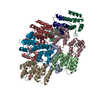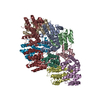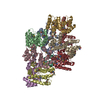+ Open data
Open data
- Basic information
Basic information
| Entry | Database: PDB / ID: 8yd7 | ||||||
|---|---|---|---|---|---|---|---|
| Title | Structure of FADD/Caspase-8/cFLIP death effector domain assembly | ||||||
 Components Components |
| ||||||
 Keywords Keywords | APOPTOSIS / FADD / Caspase-8 / cFLIP / death effector domain | ||||||
| Function / homology |  Function and homology information Function and homology informationpositive regulation of CD8-positive, alpha-beta cytotoxic T cell extravasation / negative regulation of activation-induced cell death of T cells / negative regulation of myoblast fusion / skeletal muscle atrophy / skeletal myofibril assembly / caspase-8 / syncytiotrophoblast cell differentiation involved in labyrinthine layer development / death effector domain binding / tumor necrosis factor receptor superfamily binding / FasL/ CD95L signaling ...positive regulation of CD8-positive, alpha-beta cytotoxic T cell extravasation / negative regulation of activation-induced cell death of T cells / negative regulation of myoblast fusion / skeletal muscle atrophy / skeletal myofibril assembly / caspase-8 / syncytiotrophoblast cell differentiation involved in labyrinthine layer development / death effector domain binding / tumor necrosis factor receptor superfamily binding / FasL/ CD95L signaling / TRAIL signaling / CD95 death-inducing signaling complex / regulation of skeletal muscle satellite cell proliferation / Apoptotic execution phase / death-inducing signaling complex assembly / Activation, myristolyation of BID and translocation to mitochondria / ripoptosome / Defective RIPK1-mediated regulated necrosis / Microbial modulation of RIPK1-mediated regulated necrosis / TRAIL-activated apoptotic signaling pathway / caspase binding / TRIF-mediated programmed cell death / Regulation by c-FLIP / CASP8 activity is inhibited / Dimerization of procaspase-8 / TLR3-mediated TICAM1-dependent programmed cell death / regulation of necroptotic process / positive regulation of extracellular matrix organization / positive regulation of adaptive immune response / self proteolysis / Caspase activation via Death Receptors in the presence of ligand / positive regulation of macrophage differentiation / negative regulation of hepatocyte apoptotic process / positive regulation of glomerular mesangial cell proliferation / response to cobalt ion / necroptotic signaling pathway / skeletal muscle tissue regeneration / positive regulation of hepatocyte proliferation / NF-kB activation through FADD/RIP-1 pathway mediated by caspase-8 and -10 / CLEC7A/inflammasome pathway / death-inducing signaling complex / receptor serine/threonine kinase binding / negative regulation of necroptotic process / regulation of tumor necrosis factor-mediated signaling pathway / positive regulation of type I interferon-mediated signaling pathway / tumor necrosis factor receptor binding / positive regulation of innate immune response / death receptor binding / natural killer cell activation / positive regulation of extrinsic apoptotic signaling pathway / TNFR1-induced proapoptotic signaling / motor neuron apoptotic process / negative regulation of cellular response to transforming growth factor beta stimulus / negative regulation of cardiac muscle cell apoptotic process / RIPK1-mediated regulated necrosis / response to anesthetic / execution phase of apoptosis / regulation of innate immune response / Apoptotic cleavage of cellular proteins / pyroptotic inflammatory response / response to testosterone / positive regulation of activated T cell proliferation / response to tumor necrosis factor / B cell activation / T cell homeostasis / positive regulation of proteolysis / macrophage differentiation / extrinsic apoptotic signaling pathway via death domain receptors / positive regulation of execution phase of apoptosis / Caspase-mediated cleavage of cytoskeletal proteins / cellular response to dexamethasone stimulus / lymph node development / negative regulation of extrinsic apoptotic signaling pathway via death domain receptors / skeletal muscle tissue development / behavioral response to cocaine / spleen development / negative regulation of reactive oxygen species biosynthetic process / extrinsic apoptotic signaling pathway / signaling adaptor activity / extrinsic apoptotic signaling pathway in absence of ligand / negative regulation of canonical NF-kappaB signal transduction / cysteine-type peptidase activity / cellular response to nitric oxide / regulation of cytokine production / proteolysis involved in protein catabolic process / cellular response to epidermal growth factor stimulus / T cell activation / thymus development / protein maturation / positive regulation of interleukin-1 beta production / positive regulation of interleukin-8 production / negative regulation of extrinsic apoptotic signaling pathway / Regulation of NF-kappa B signaling / apoptotic signaling pathway / kidney development / enzyme activator activity / cellular response to estradiol stimulus / Regulation of TNFR1 signaling / cellular response to mechanical stimulus / NOD1/2 Signaling Pathway Similarity search - Function | ||||||
| Biological species |  Homo sapiens (human) Homo sapiens (human) | ||||||
| Method |  X-RAY DIFFRACTION / X-RAY DIFFRACTION /  SYNCHROTRON / SYNCHROTRON /  SAD / Resolution: 3.32 Å SAD / Resolution: 3.32 Å | ||||||
 Authors Authors | Lin, S.-C. / Yang, C.-Y. | ||||||
| Funding support |  Taiwan, 1items Taiwan, 1items
| ||||||
 Citation Citation |  Journal: Nat Commun / Year: 2024 Journal: Nat Commun / Year: 2024Title: Deciphering DED assembly mechanisms in FADD-procaspase-8-cFLIP complexes regulating apoptosis. Authors: Chao-Yu Yang / Chia-I Lien / Yi-Chun Tseng / Yi-Fan Tu / Arkadiusz W Kulczyk / Yen-Chen Lu / Yin-Ting Wang / Tsung-Wei Su / Li-Chung Hsu / Yu-Chih Lo / Su-Chang Lin /   Abstract: Fas-associated protein with death domain (FADD), procaspase-8, and cellular FLICE-inhibitory proteins (cFLIP) assemble through death-effector domains (DEDs), directing death receptor signaling ...Fas-associated protein with death domain (FADD), procaspase-8, and cellular FLICE-inhibitory proteins (cFLIP) assemble through death-effector domains (DEDs), directing death receptor signaling towards cell survival or apoptosis. Understanding their three-dimensional regulatory mechanism has been limited by the absence of atomic coordinates for their ternary DED complex. By employing X-ray crystallography and cryogenic electron microscopy (cryo-EM), we present the atomic coordinates of human FADD-procaspase-8-cFLIP complexes, revealing structural insights into these critical interactions. These structures illustrate how FADD and cFLIP orchestrate the assembly of caspase-8-containing complexes and offer mechanistic explanations for their role in promoting or inhibiting apoptotic and necroptotic signaling. A helical procaspase-8-cFLIP hetero-double layer in the complex appears to promote limited caspase-8 activation for cell survival. Our structure-guided mutagenesis supports the role of the triple-FADD complex in caspase-8 activation and in regulating receptor-interacting protein kinase 1 (RIPK1). These results propose a unified mechanism for DED assembly and procaspase-8 activation in the regulation of apoptotic and necroptotic signaling across various cellular pathways involved in development, innate immunity, and disease. | ||||||
| History |
|
- Structure visualization
Structure visualization
| Structure viewer | Molecule:  Molmil Molmil Jmol/JSmol Jmol/JSmol |
|---|
- Downloads & links
Downloads & links
- Download
Download
| PDBx/mmCIF format |  8yd7.cif.gz 8yd7.cif.gz | 432 KB | Display |  PDBx/mmCIF format PDBx/mmCIF format |
|---|---|---|---|---|
| PDB format |  pdb8yd7.ent.gz pdb8yd7.ent.gz | 287 KB | Display |  PDB format PDB format |
| PDBx/mmJSON format |  8yd7.json.gz 8yd7.json.gz | Tree view |  PDBx/mmJSON format PDBx/mmJSON format | |
| Others |  Other downloads Other downloads |
-Validation report
| Summary document |  8yd7_validation.pdf.gz 8yd7_validation.pdf.gz | 493.9 KB | Display |  wwPDB validaton report wwPDB validaton report |
|---|---|---|---|---|
| Full document |  8yd7_full_validation.pdf.gz 8yd7_full_validation.pdf.gz | 507.5 KB | Display | |
| Data in XML |  8yd7_validation.xml.gz 8yd7_validation.xml.gz | 54.2 KB | Display | |
| Data in CIF |  8yd7_validation.cif.gz 8yd7_validation.cif.gz | 73.2 KB | Display | |
| Arichive directory |  https://data.pdbj.org/pub/pdb/validation_reports/yd/8yd7 https://data.pdbj.org/pub/pdb/validation_reports/yd/8yd7 ftp://data.pdbj.org/pub/pdb/validation_reports/yd/8yd7 ftp://data.pdbj.org/pub/pdb/validation_reports/yd/8yd7 | HTTPS FTP |
-Related structure data
| Related structure data |  8ybxC  8yd8C C: citing same article ( |
|---|---|
| Similar structure data | Similarity search - Function & homology  F&H Search F&H Search |
- Links
Links
- Assembly
Assembly
| Deposited unit | 
| |||||||||||||||||||||||||||||||||||||||||||||||||||||||||||||||||||||||||||||||||||||||||||||||||||||||||||||||||||||||||||||||||||||||||||||
|---|---|---|---|---|---|---|---|---|---|---|---|---|---|---|---|---|---|---|---|---|---|---|---|---|---|---|---|---|---|---|---|---|---|---|---|---|---|---|---|---|---|---|---|---|---|---|---|---|---|---|---|---|---|---|---|---|---|---|---|---|---|---|---|---|---|---|---|---|---|---|---|---|---|---|---|---|---|---|---|---|---|---|---|---|---|---|---|---|---|---|---|---|---|---|---|---|---|---|---|---|---|---|---|---|---|---|---|---|---|---|---|---|---|---|---|---|---|---|---|---|---|---|---|---|---|---|---|---|---|---|---|---|---|---|---|---|---|---|---|---|---|---|
| 1 |
| |||||||||||||||||||||||||||||||||||||||||||||||||||||||||||||||||||||||||||||||||||||||||||||||||||||||||||||||||||||||||||||||||||||||||||||
| Unit cell |
| |||||||||||||||||||||||||||||||||||||||||||||||||||||||||||||||||||||||||||||||||||||||||||||||||||||||||||||||||||||||||||||||||||||||||||||
| Noncrystallographic symmetry (NCS) | NCS domain:
NCS domain segments:
|
 Movie
Movie Controller
Controller





 PDBj
PDBj









